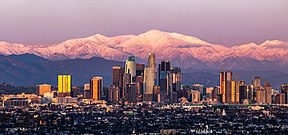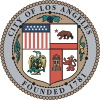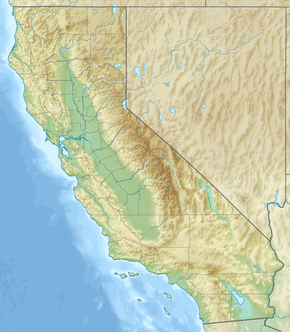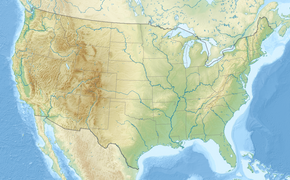Los Angeles
Los Angeles (L.A.), officially the City of Los Angeles, is the largest city in California, in the United States. There are 3,847,400 people living in the city, and over 18 million people in the L.A. region. The city has an area of 1,200 square kilometres (460 sq mi). Los Angeles is the city with the second biggest population in the United States after New York, overtaking Chicago in the 1970s.
Los Angeles, California | |
|---|---|
Clockwise from top: Central Los Angeles skyline, Griffith Observatory, City Hall, Venice Beach, Theme Building at Los Angeles International Airport, Dodger Stadium, and the Hollywood Sign | |
| Nickname(s): | |
 Map of Los Angeles County, California, with Los Angeles highlighted | |
| Coordinates: 34°03′N 118°15′W / 34.050°N 118.250°W | |
| Country | |
| State | |
| County | |
| Region | Southern California |
| CSA | Los Angeles-Long Beach |
| MSA | Los Angeles-Long Beach-Anaheim |
| Pueblo | September 4, 1781[2] |
| City status | May 23, 1835[3] |
| Incorporated | April 4, 1850[4] |
| Named for | Our Lady, Queen of the Angels |
| Government | |
| • Type | Mayor-Council[5] |
| • Body | Los Angeles City Council |
| • Mayor | Karen Bass (D) |
| • City Attorney | Hydee Feldstein Soto (D) |
| • City Controller | Kenneth Mejia (D) |
| Area | |
| • Total | 501.55 sq mi (1,299.01 km2) |
| • Land | 469.49 sq mi (1,215.97 km2) |
| • Water | 32.06 sq mi (83.04 km2) |
| Elevation | 305 ft (93 m) |
| Highest elevation | 5,074 ft (1,547 m) |
| Lowest elevation | 0 ft (0 m) |
| Population | 3,898,747 |
| • Rank | 2nd in the United States 1st in California |
| • Density | 8,304.22/sq mi (3,206.29/km2) |
| • Metro | 13,200,998 (2nd) |
| Demonym(s) | Los Angeleno, Angeleno |
| Time zone | UTC−08:00 (Pacific) |
| • Summer (DST) | UTC−07:00 (PDT) |
| ZIP Codes | List
|
| Area codes | 213/323, 310/424, 747/818 |
| FIPS code | 06-44000 |
| GNIS feature IDs | 1662328, 2410877 |
| Major Airport | Los Angeles International Airport (LAX) |
| Rapid Transit | Los Angeles County Metropolitan Transportation Authority |
| Website | lacity.gov |
It is a car-centric city requiring much parking, and one of the most spread out cities in the world. Greater Los Angeles is home to many movie stars and many of the biggest rock bands in the history of the United States. Los Angeles is surrounded by East Los Angeles, Huntington Park, Maywood, Walnut Park, Commerce, Bell, Glendale, South Pasadena, Monterey Park, South Gate, Carson, Cudahy, West Hollywood, Alhambra, Bell Gardena and Westmont.[12]
Los Angeles has Spanish and Mexican influences due to being a former colony of Mexico and Spain. Los Angeles is a diverse city with many ethnic groups such as Mexican, Japanese, Korean, Vietnamese, Italian, Salvadoran, Greek and Armenian. Mexican and Spanish architecture can be seen in Los Angeles.
Many celebrities live in Los Angeles. Los Angeles is known to be the entertainment capital of the world. Many movies, television shows and fashion shows are made in Hollywood and are often set in Los Angeles.
Los Angeles has the second largest Hispanic and Latino population in the United States, only behind New York City. Many are of Mexican and Central American descent. [13]
Los Angeles is one of the most expensive cities to live in.
History
changeThe area comprising present-day Los Angeles County was first settled by small groups of Native Americans for centuries before the first European contact in 1769 when Gaspar de Portola and a group of missionaries camped on what is now the banks of the Los Angeles River. The name Los Angeles comes from the Spanish language,and it means "The Angels". The name is an abbreviation from the original name of the place. The original name is "El Pueblo de Nuestra Señora la Reina de los Ángeles del Río Porciúncula" (in English, "The Town of Our Lady the Queen of the Angels of the River Porciúncula"), giving it both one of the longest and shortest (referring to its shortening of "LA") place names in the world.[14] Los Angeles was founded in 1781 while the area was within the borders of the Viceroyalty of New Spain. The area had earlier been explored by two Franciscan priests named Junipero Serra and Juan Crespi and following the Mexican War of Independence the region passed into the hands of Mexico which subsequently ceded control of California to the U.S. in 1848. On April 4, 1850 California became a State of the USA. Los Angeles began half a century of rapid growth after railroads arrived in the city in the 1870s. Los Angeles was home to the Olympic Games in 1932 and 1984. It will host the Olympic Games in 2028. Three times the city broke out in riots, in 1943, in 1965, and in 1992, all due to racism.[15][16] In 1994, an earthquake killed 72 people and damaged many buildings.
Demographics
changeLos Angeles has the second largest Mexican, Armenian, Salvadoran, Filipino and Guatemalan population by city in the world, the third largest Canadian population in the world, and has the largest Japanese, Iranian/Persian, Cambodian and Roma (Gypsy) population in the country.[17]
Christianity is the most practiced religion in Los Angeles.[18]
Spanish is the most spoken foreign language in Los Angeles. Korean, Filipino, Armenian, Chinese, and Persian are also spoken in the city.[19]
2020 census
changeIn the 2020 census, there were 3,898,747 people, 1,410,260 households, and 839,676 families living in Los Angeles. The population density was 8,304.2 people per square mile (3,206.3/km²). There were 1,496,453 housing units. The breakdown by race was 34.9% White, 11.9% Asian, 8.6% Black, 1.7% Native American, 0.2% Pacific Islander, 29.5% from one other race, and 13.3% from two or more races. Hispanics and Latinos made up 46.9% of the people.
The median (middle) age was 36.5 years. The age breakdown was 19.3% under age 18, 67.2% from 18 to 65, and 13.6% over 65. The gender breakdown was 49.4% male and 50.6% female.
Of the households, 28.3% had children under age 18, 37.0% had a married couple, 8.4% had an unmarried couple, 31.5% had a woman with no partner, 23.1% had a man with no partner, and 29.2% had one person living alone. The average household size was 2.68 people.[20][21]
Tourism
changeMost tourists in Los Angeles come from Mexico, Canada, China, Australia, Japan, UK, South Korea, Germany, France, Scandinavia, the Middle East and India.[22]
Geography
changeLos Angeles is a very large city, and the edges of the city are very far from the center, going from the beaches to the mountains. The Santa Monica Mountains run through the city, separating it into the San Fernando Valley to the north and the Los Angeles Basin to the south. The Los Angeles River also runs through the city some 51 miles (82 km). Los Angeles moves about one-quarter of an inch (6.3 millimeters) to the east every year.[23] It is caused by the city's tectonic plates and rough ground geography and since Los Angeles is at a close distance with the San Andreas Fault. This brings Los Angeles and San Francisco 2.5 inches (64 mm) closer together each year.
Climate
changeThe climate in Los Angeles is a Mediterranean climate. The weather is usually warm and dry during the summer, and it is mild and more rainy in the winter. The weather is different depending on how far away from the ocean you are, so places near the beach usually do not get as hot in the summer. It is very rare for temperatures to go below freezing near the coast, but can occur further inland. The city receives about 15 inches (380 mm) of rain each year, although the amount can change a lot from year to year. Snow is very rare except on the mountain tops where some occasional light snow might fall.
Sights
changeL.A. has many famous sights. There are many very long beaches, such as Venice Beach. Many visitors go to Hollywood, home to the Hollywood Walk of Fame, Grauman's Chinese Theatre, and L.A. Live, an entertainment complex. Los Angeles also has many fine museums such as the L.A. County Museum of Art, California Science Center and the Getty Museum. Another sight is the Los Angeles City Zoo. Los Angeles is the only major city in the world with an active population of wild mountain lions.[23]
Industries
changeLos Angeles is known for its large movie and television industry. Much of this is located in Hollywood. Some military aircraft are also made there, as well as spacecraft. The music industry is also concentrated in the area. The city is also a banking center. The San Pedro area has a busy port.
Neighborhoods
changeLos Angeles has dozens of neighborhoods and named areas, including:
- Hollywood, home of many well-known movie studios.
- Downtown Los Angeles, the financial centre of the city. Home to Los Angeles' and California's two tallest buildings, the Wilshire Grand Center and the U.S. Bank Tower
- Elysian Park, home of Dodger Stadium and previously Chavez Ravine.
- Venice Beach.
- Santa Monica, beachfront district (officially a separate city).
- Inglewood, home of SoFi Stadium and The Forum (officially a separate city).
- Brentwood, a very wealthy area in West Los Angeles.
- South L.A. the center of LA's African-American jazz scene
- Leimert Park, home to LA’s historic African-American museums.
- Crenshaw, a well-known district in South Los Angeles.
- University Park, home to the University of Southern California.
- Westwood, home to the University of California.
- Boyle Heights, where many Mexican Americans reside.
- Exposition Park, home to the University of Southern California, the Coliseum, Banc of California Stadium and the California Science Center are located
- San Fernando Valley, a large suburban area.
- San Pedro, where the Port of Los Angeles is located in the city.
Politics
changeAs of December 2022, the mayor of Los Angeles is Karen Bass.
Cityscape
changeMusic
changeLos Angeles has a rich history and culture of popular music. Many of the most notable recording artists in the history of the United States either started or flourished in Los Angeles or Greater Los Angeles. The surf music scene is largely associated with Los Angeles and suburbs like Malibu. Motown Records moved from Detroit, Michigan to Los Angeles in the 1970s. The West Coast Hip-hop scene and genres such as G-funk are largely centered in Greater Los Angeles.
Notable bands include:
- The Beach Boys
- The Doors
- The Mamas & the Papas
- Metallica
- Red Hot Chili Peppers
- Eagles
- Guns 'n' Roses
- The Byrds
- Love
- Spirit
- Rage Against the Machine
- Buffalo Springfield
- Beck
- The Offspring
- Tool
- No Doubt
- System of a Down
- Linkin Park
- X
- N.W.A.
- Jane's Addiction
- Sublime (nearby Long Beach)
- Steppenwolf
- Incubus
- Sugar Ray
- The Wallflowers
- Black Flag
Media
changeKABC American Broadcasting Company
Amphibia (Subsequently removed)
References
change- ↑ 1.0 1.1 1.2 Gollust, Shelley (April 18, 2013). "Nicknames for Los Angeles". Voice of America. Retrieved June 26, 2014.
- ↑ Barrows, H.D. (1899). "Felepe de Neve". Historical Society of Southern California Quarterly. Vol. 4. p. 151ff. Retrieved September 28, 2011.
- ↑ "This 1835 Decree Made the Pueblo of Los Angeles a Ciudad – And California's Capital". KCET. April 2016. Retrieved January 27, 2018.
- ↑ "California Cities by Incorporation Date". California Association of Local Agency Formation Commissions. Archived from the original (DOC) on February 21, 2013. Retrieved August 25, 2014.
- ↑ "About the City Government". City of Los Angeles. Archived from the original on February 8, 2015. Retrieved February 8, 2015.
- ↑ "2021 U.S. Gazetteer Files". United States Census Bureau. Retrieved September 7, 2021.
- ↑ "Los Angeles City Hall". Geographic Names Information System. United States Geological Survey. Retrieved October 16, 2014.
- ↑ 8.0 8.1 "Elevations and Distances". US Geological Survey. April 29, 2005. Archived from the original on November 9, 2013. Retrieved February 10, 2015.
- ↑ "QuickFacts: Los Angeles city, California". U.S. Census Bureau. Retrieved September 9, 2021.
- ↑ "2020 Population and Housing State Data". United States Census Bureau. Retrieved 22 August 2021.
- ↑ Zip Codes Within the City of Los Angeles – LAHD
- ↑ "Cities Near Me - Los Angeles, California | Travelmath".
- ↑ 11 Cities With the Most Hispanics
- ↑ "City of Angels' First Name Still Bedevils Historians". The Los Angeles Times. March 26, 2005. Retrieved June 26, 2020.
- ↑ "Zoot Suit Riots | Summary, Causes, Significance, & Facts". Encyclopedia Britannica. Retrieved 2020-11-18.
- ↑ Szymanski, Michael (1990-08-05). "How Legacy of the Watts Riot Consumed, Ruined Man's Life". Orlando Sentinel. Retrieved 2020-11-18.
- ↑ The Power of Place: Urban Landscapes as Public History. p. 83.
- ↑ Demographics of Los Angeles - Rex Hamilton, MD
- ↑ Top Languages Spoken in Los Angeles
- ↑ "DP1: PROFILE OF GENERAL POPULATION AND HOUSING CHARACTERISTICS". United States Census Bureau. Retrieved July 16, 2024.
- ↑ "P16: HOUSEHOLD TYPE". United States Census Bureau. Retrieved July 16, 2024.
- ↑ https://www.discoverlosangeles.com/media/facts-about-la
- ↑ 23.0 23.1 "Frey crafts a new view of modern-day Los Angeles". Today.com. Retrieved November 27, 2013.











